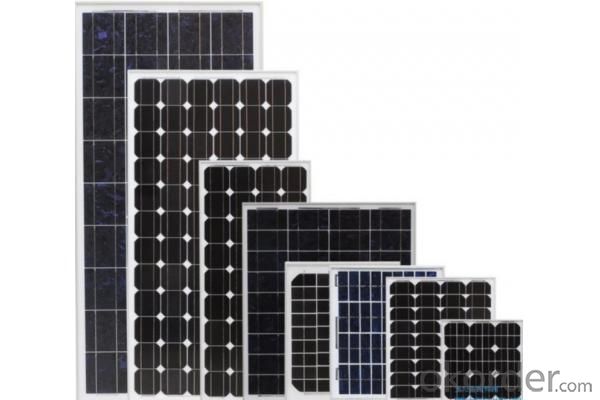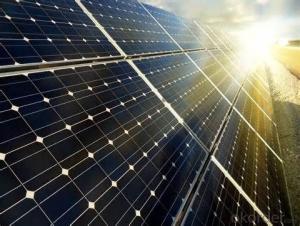205w Poly Solar Module With High Efficiency
- Loading Port:
- Tianjin
- Payment Terms:
- TT OR LC
- Min Order Qty:
- 1 watt
- Supply Capability:
- 100000 watt/month
OKorder Service Pledge
OKorder Financial Service
You Might Also Like
Item specifice
Product Description:
1.Structure of Solar Module Description
CNBM Solar's photovoltaic module is designed for designed for large electrical power requirement. It is the optimal choice for both on-grid and off-grid power systems. CNBM Solar offers high performance of power per square foot of solar array.
2.Main Features of the Solar Module
Solar Cell: High efficency crystalline solar cell. Even if under the weak light, the solar module can produce maximum power output.
Tempered glass: Anti-reflecting coating and high transmission rate glass increase the power output and mechanical strength of solar module.
EVA and TPT: Using high quality EVA and TPT to prevent destroying and water.
Strong aluminum frames to strengthen the load hold and to stand against high wind.
Junction box: Multi function junction box with water proof.
Long lifetime: ≥25 years; Less power decrease.
Good performance of preventing from atrocious weather such as wind and hails.
Resisting moisture and etching effectively, not effected by geology.
The certificate issued by international authority: UL, TUV, IEC, VDE, CE.

Solar panel working process
In addition to being the ultimate source of all life on earth, the sun is an infinitely renewable, completely pollution-free source of electricity. Instead of burning fossil fuels dug up from the ground in a big power plant – a very 19th century, industrial age approach, when you think about it – solar panels convert sunlight directly into electricity, with no harmful emissions.
The basic unit of a solar panel is a solar cell, which usually consists of one or two layers of silicon-based semiconductor wafers. When struck by the photons in sunlight, the solar cell generates an electrical charge due to the "photovoltaic effect" – which is a pretty good name, since it produces voltage from photons. The flow of these electrons moves in a steady electrical current from one side of the cell to the other.
Dozens of these PV cells are packaged together into solar modules, which in turn are packaged into solar panels that are mounted on a rooftop and arranged to maximize their hours of exposure to direct sunlight. Because the electricity generated by all those solar cells is direct current (DC), it is then sent to an inverter that transforms the power into the same alternating current (AC) used by the appliances in your home and the local utility electricity distribution grid. Increasingly, these inverters are getting "smart," providing data monitoring for solar installation performance and other grid integration services.
- Q:What are the benefits of using solar panels?
- There are several benefits to using solar panels. Firstly, solar energy is a renewable source of energy, meaning it will never run out. It also produces clean energy, which reduces greenhouse gas emissions and helps combat climate change. Solar panels can help homeowners and businesses save money on their electricity bills by generating their own energy. Additionally, solar panels require minimal maintenance and have a long lifespan, making them a cost-effective investment in the long run. Finally, using solar panels can also contribute to energy independence, as it reduces reliance on traditional fossil fuels and centralized power grids.
- Q:Can solar panels power an entire home?
- Yes, solar panels can power an entire home. The number of solar panels required will depend on the energy needs of the home and the efficiency of the panels. With the right setup and sufficient sunlight, solar panels can generate enough electricity to cover the energy consumption of a household.
- Q:Can solar panels be installed on historic homes or buildings?
- Yes, solar panels can be installed on historic homes or buildings. However, it is important to consider the specific regulations and guidelines in place for historic preservation in each jurisdiction. In some cases, there may be restrictions on the placement and design of solar panels to ensure they do not detract from the historical integrity of the property. It is advisable to consult with preservation authorities or experts to determine the feasibility and appropriate approach for solar panel installation on historic structures.
- Q:I just moved into somewhere with solar panels but don't really understand them...all I know is that they heat the water.Do I still have to turn the hot water on with the solar panels or do they heat it automatically or do they store the energy until I turn on the hot water?!
- Custom solar-heating systems are unique. Does yours have a circulating pump? Does it have a storage tank? Is the fluid that goes to the panels separated from the household water and transfers heat through a heat-exchanger radiator, and the fluid has antifreeze in it? If it does, is the antifreeze of the variety that won't poison your family if there is a leak? Does your system have a thermostat-controlled pump that turns on when the water in the panels are hot? Does it have a limit-thermostat to turn off the pump when water in the storage tank is hot? There are many more variations to operation of solar-heating panels. Find out who designed it or who knows how to operate it and ask them.
- Q:Can solar panels be installed in a remote location?
- Yes, solar panels can be installed in a remote location. In fact, remote locations with abundant sunlight can be ideal for solar panel installations as they can generate electricity even without access to a traditional power grid. The advancements in solar technology and the ability to store excess energy in batteries make it easier to set up and maintain solar systems in remote areas.
- Q:Can solar panels be installed on warehouses?
- Yes, solar panels can be installed on warehouses. In fact, warehouses are often ideal locations for solar panel installations due to their large roof spaces, which can accommodate a significant number of panels to generate clean and renewable energy. Additionally, warehouses tend to have uninterrupted sunlight exposure, making them well-suited for solar energy generation.
- Q:Can solar panels be used to power a military vehicle?
- Yes, solar panels can be used to power a military vehicle. Advances in technology have allowed for the development of lightweight and flexible solar panels that can be integrated into the structure of military vehicles. These solar panels can capture sunlight and convert it into electrical energy to power various systems and reduce reliance on traditional fuel sources. Implementing solar panels can enhance the sustainability and operational efficiency of military vehicles in certain scenarios.
- Q:I need a solar panel for my laptop as i am going camping in the desert, and i need my laptop. There are two choices of solar panels, One is 0 watts and 2 V and maximum power current 0.56 amps. The other one is 2 watts, 2 V and no mention of current. My laptop plug says input 00-240V and .5A and then output 5V-5A. Which one should i get for my laptop. If there are other choices please tell me ill look them up on OKorder.Thanks
- I'm afraid neither of these panels will do much for charging or running your laptop. If the power brick is supposed to emit 5 volts at 5 amps, that's 75 watts. Neither of those panels provides enough voltage and the power output is obviously far too small. The capabilities of solar power are vastly overestimated for small panels. Sunlight is limited to about kilowatt per square meter under ideal conditions (summer time, clear blue sky, for a few hours around noon in the US southwest). But consumer panels top out at about 5% efficiency, so your limit is 50 watts per square meter - in other words you would need about half a square meter, or about six square feet, of panel to provide 75 watts. And even under ideal conditions you will only get that much for a few hours each day. Also, the panel's voltage output is not regulated, so even if you find a panel that emits 5 volts (this would actually have to be made up of groups of 30 cells in series, as they emit half a volt each at most) you can't just connect the panel output into your laptop's DC in. You'd need a regulated DC-to-DC supply, and since that is not 00% efficient it will cost a bit of the power... now you need even more panel area. All in all, not really a practical thing to carry along on a camping trip.
- Q:Can solar panels be installed on camping sites?
- Yes, solar panels can be installed on camping sites. They are a great renewable energy option for powering small electronic devices, lighting, and charging batteries while camping.
- Q:Ok Im trying to power my room using solar panels and I've figure out that I need about 700 watts to do so, but I really only use my electronics at night. I was wondering if I could buy lets say a 200 watt solar panel and let it charge a battery all day would that work? I live in southern california so I dont have to worry to much about cloudy days. also any suggestions on where to buy a panel, inverter, charge regulator, and battery?
- Solar panels range fromwatt to 200 watts. Most panels up to30 watts are 2volts. Siemens puts out a module (SM0) that is rated at 0 watts, 2volt, and 6.3 amps.weight (without a frame) .5 kg ms 660mm by 36mm., .868 sq meters, 26.73 watts/m^2. Do a google search for solar panels. Southern Cal. should have lots of suppliers. I know there is one in Arizona.
1. Manufacturer Overview |
|
|---|---|
| Location | |
| Year Established | |
| Annual Output Value | |
| Main Markets | |
| Company Certifications | |
2. Manufacturer Certificates |
|
|---|---|
| a) Certification Name | |
| Range | |
| Reference | |
| Validity Period | |
3. Manufacturer Capability |
|
|---|---|
| a)Trade Capacity | |
| Nearest Port | |
| Export Percentage | |
| No.of Employees in Trade Department | |
| Language Spoken: | |
| b)Factory Information | |
| Factory Size: | |
| No. of Production Lines | |
| Contract Manufacturing | |
| Product Price Range | |
Send your message to us
205w Poly Solar Module With High Efficiency
- Loading Port:
- Tianjin
- Payment Terms:
- TT OR LC
- Min Order Qty:
- 1 watt
- Supply Capability:
- 100000 watt/month
OKorder Service Pledge
OKorder Financial Service
Similar products
New products
Hot products
Related keywords





























